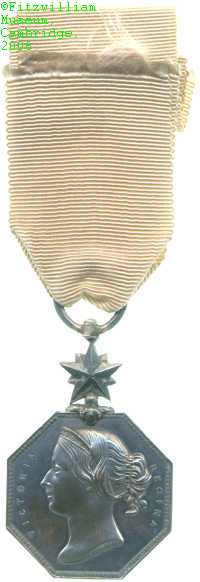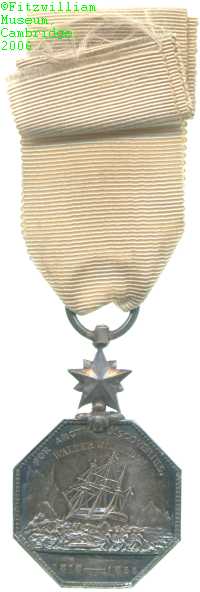
Obverse, a bust of Queen Victoria

Reverse, sledging party in foreground before three-masted ship, icebergs in background

Obverse, a bust of Queen Victoria |

Reverse, sledging party in foreground before three-masted ship, icebergs in background |
This was the first British medal issued for polar exploration. Its issue was not confined to British explorers, and was also made to those of other nations, both servicemen and civilians.
One of the least successful of the Polar expeditions was one led by Sir John Franklin, the Governor of Tasmania, who had sailed on three previous expeditions, one likewise near-disastrous but others less so. In 1845 he took HMS Erebus and HMS Terror to chart the last unknown parts of the North-West Passage. The ships reached Baffin Island and were never seen again thereafter. The ensuing search for Franklin became a popular cause célèbre. Between 1850 and 1856 several lucky finds pieced together a story of ships locked in ice for two successive winters, starvation, and eventual death in an overland escape trek. Franklin himself seems to have died at King William Island on 25 April 1848. The ends of the party are still controversial.
One of the more heroic stories of the search for Franklin is that of an expedition mounted in 1853 by an American, Elisha Kent Kane. Kane also ran into terrible difficulty and the party, except for one man, were rescued only after an 83-day march from their stranded ship in 1855. They were picked up at Upernavik by two other American vessels, USS Arctic and USS Release.
This medal is privately engraved to Walter Wilkinson, who served aboard USS Arctic on the voyage to rescue Kane. It would seem that Wilkinson decided that, as the medal had come from the King, his ship should be identified thereon as a ship of His Majesty, and so it is engraved to him on "HMS Arctic". Lester Watson acquired the medal at some point before 1928.
The Museum is grateful to Mr G. M. Stein and Rear Admiral J. A. L. Myres for information on the award of this medal.